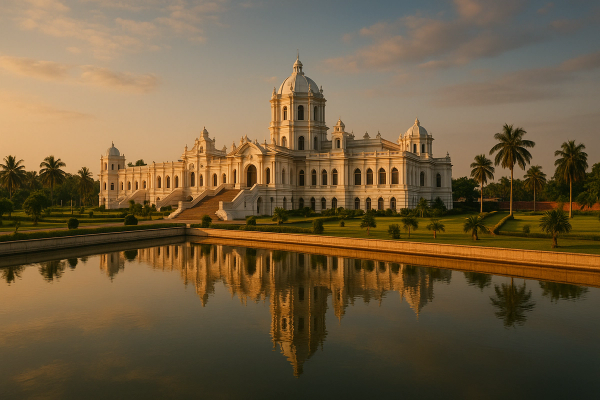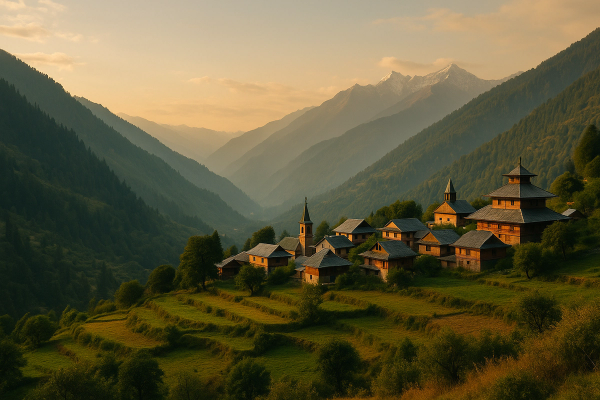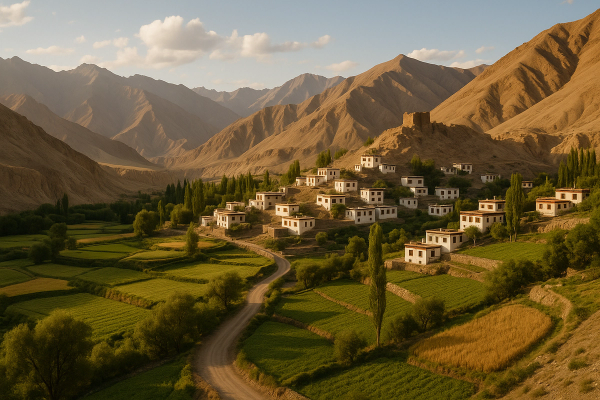
Okay, Let's Talk About Getting Soaked: White Water Rafting in Kullu-Manali#
Alright, so you're thinking about Himachal Pradesh. Good choice, seriously. Mountains, amazing views, that crisp air... but maybe you're looking for something a bit... more? Something to get the heart hammering against your ribs? Yeah, me too sometimes. If that sounds like you, then Himachal Pradesh Adventure basically screams White Water Rafting in Kullu-Manali. We're talking about tackling the Beas River, and trust me, it's a blast.¶
I remember the first time I saw the Beas churning through the valley near Kullu. It's this powerful, kinda mesmerizing force of nature. And the idea of actually getting in it, on a raft? Simultaneously terrifying and ridiculously exciting. So, if you're game for some serious fun and maybe swallowing a bit of river water (happens to the best of us lol), stick around. I'll spill everything I know about Beas River Rafting – the good, the splashy, and the slightly scary parts.¶

First Off: Kullu-Manali - What's the Vibe?#
So, Kullu and Manali, they're kinda like sister towns nestled in the Himachal mountains. Kullu Valley is famous for its beauty, often called the 'Valley of the Gods,' which sounds kinda epic, right? Manali is usually the main hub for tourists heading further up or just chilling. Think backpacker cafes, adventure shops, and stunning Himalayan backdrops everywhere you look.¶
The Beas River cuts right through this landscape, flowing down from the high Himalayas. It's the lifeblood of the valley, and yeah, it's also our playground for some awesome Manali Adventure Sports. It's not just rafting, there's paragliding, trekking, skiing (in winter, obvs)... it's a proper Himachal Travel hotspot for anyone who likes moving.¶
The Main Event: River Rafting Kullu Style!#
Okay, let's get down to the nitty-gritty: the actual rafting. The Beas River offers different stretches, mostly between Kullu and Manali, specifically around a place called Pirdi. The river's mood changes depending on the season and the section, so you can kinda choose your own adventure level. Which is nice.¶

Decoding the Rafting Stretches & Grades#
They usually classify the rapids using grades, like Grade I (easy peasy, tiny waves) up to Grade V (expert territory, big drops, very technical). Most commercial rafting on the Beas hangs around the Grade II and III mark, sometimes touching Grade IV depending on the water levels.¶
- Short Stretch (Approx. 7 km, near Pirdi): This is usually Grade II-III. Perfect for beginners or families. Takes about 30-45 minutes on the water. It's enough to get the feel, scream a bit, get splashed, and have a laugh. Honestly, a great intro to Water Sports Himachal.
- Standard Stretch (Approx. 14 km, Pirdi to Jhiri): The most popular one. Definitely the one I'd recommend if you want a bit more action. This usually hits Grade II and III+ rapids. Takes maybe 1 to 1.5 hours. You get a good mix of calm stretches to enjoy the view and properly bumpy sections that require some serious paddling. This is classic River Rafting Kullu.
- Longer Stretches (Can go up to 20km+): Sometimes offered, especially when water levels are good. These might include some Grade IV rapids, especially post-monsoon or early summer melt. These are for the more adventurous souls or people who've rafted before. Check with operators specifically about these.
Heads up: These grades and times are approximate, okay? The river changes constantly. What's Grade II one week might feel more like Grade III the next if there's been heavy rain or snowmelt. Always trust your guide's assessment on the day.
Safety First, Fun Second (Okay, Maybe Tied for First)#
Not gonna lie, jumping into a fast-flowing river has risks. But legit operators take safety super seriously. Here's the deal:¶
- Briefing: You'll get a safety talk before you even touch the raft. LISTEN TO THIS. They'll tell you how to paddle, what to do if you fall out (yes, it can happen!), and commands the guide will shout.
- Gear: You have to wear a life jacket (PFD - Personal Flotation Device) and a helmet. No arguments. They should provide these, make sure they fit snugly.
- Guide: Your raft will have a trained, certified guide. These guys know the river like the back of their hand. Follow their instructions, paddle when they say paddle, stop when they say stop.
- The Raft: Should be a sturdy inflatable raft designed for whitewater.
- Rescue: Often, there's a safety kayaker or another raft keeping an eye on things, especially on tougher sections.
Seriously, don't skimp on safety to save a few bucks. Go with a reputable operator. More on that later...¶
When's the Best Time for This Himachal Pradesh Adventure?#
Timing is kinda key for rafting, mainly 'cause the river flow changes dramatically. You want enough water for fun rapids, but not so much that it's dangerously high.¶
Prime Rafting Season (Mid-April to June)#
This is generally considered the best time. The weather's getting warmer (well, warm for the mountains!), and the snowmelt from higher up swells the Beas nicely. Expect good flows, exciting rapids, and plenty of sunshine (hopefully!).¶
- Pros: Awesome water levels, sunny weather usually, peak adventure season vibe.
- Cons: Can be crowded, prices might be slightly higher. Book ahead!
Post-Monsoon Rush (Mid-September to October)#
After the monsoon rains (July-August, when rafting usually stops 'cause the river is just too wild and unpredictable), there's another window. The river is often still quite full, the landscape is ridiculously green, and the air is crisp and clear.¶
- Pros: Lush scenery, good water levels (can sometimes be quite powerful!), fewer summer crowds.
- Cons: Water can be colder, weather can be a bit unpredictable as winter approaches.
What About Other Times?#
Monsoon (July - Early September): Generally a NO-GO. The Beas can become dangerously swollen and unpredictable. Most operators shut down rafting operations during peak monsoon for safety reasons. Seriously, don't even try.¶
Winter (November - March): Water levels are usually too low, and it's FREEZING. Like, painfully cold. Rafting isn't really a thing then. Stick to skiing or cozy cafes.¶
My personal sweet spot? Probably late May/early June or late September. You get the thrills without the absolute peak season madness or the iffy monsoon conditions.
Finding Your Raft Crew: Recommended Operators#
Okay, this is important. There are TONS of operators along the Kullu-Manali highway, especially around Pirdi. It can be kinda overwhelming. Price isn't everything – safety gear, guide experience, and proper permits matter WAY more.¶
Honestly, naming specific operators is tricky 'cause things change. My best advice:¶
- Look for Experience: Ask how long they've been operating. Longer track record is usually a good sign.
- Check Reviews: Look 'em up online (TripAdvisor, Google, etc.). See what recent rafters are saying. Pay attention to comments about safety.
- Inspect the Gear: Does the equipment look reasonably new and well-maintained? Are the life jackets and helmets in good condition?
- Talk to the Guides: If possible, chat with the guides. Do they seem professional, knowledgeable, and confident? Do they speak your language comfortably?
- Ask About Certification/Permits: Reputable operators should be registered and have the necessary permits from the Himachal tourism department or relevant authorities.
- Avoid Super Cheap Deals: If a price seems too good to be true, it probably is. They might be cutting corners on safety, insurance, or guide quality. Expect to pay somewhere in the range of ₹800 to ₹2000+ per person depending on the stretch length and operator quality (prices change, so this is just a ballpark!).
Some names that often pop up and generally have good reputations include Himalayan River Runners, Himalayan Adventure Trips, Gerry's Rafting... but seriously, do your own quick check before booking. Maybe ask your hotel or guesthouse for a recommendation too.¶
Beyond the Raft: Making it a Proper Himachal Trip#
You're probably not just going for the rafting, right? Kullu-Manali is a whole destination. So, some quick pointers for your Himachal Travel planning:¶
Getting There & Moving Around#
- By Air: The nearest airport is Bhuntar Airport (KUU) near Kullu. Flights are limited and can be pricey/weather dependent. Chandigarh (IXC) is a bigger airport, about 8-10 hours drive away. Delhi (DEL) is the major international hub, but it's a long (12-14+ hour) overnight bus or taxi ride from there.
- By Road: This is how most people arrive. Overnight buses (Volvo/HPTDC) from Delhi or Chandigarh are super common and reasonably comfy. You can also hire taxis, but that's more expensive.
- Getting Around: In Manali/Kullu, autorickshaws and local taxis are easy to find. You can also rent motorbikes (if you're comfortable with mountain roads!) or hire a car with a driver for sightseeing.
That overnight bus from Delhi? It's kinda like a rite of passage. Bring snacks, an eye mask, and maybe something for motion sickness if you're prone. The roads get WINDY.
Where to Crash: Accommodation#
Loads of options here, catering to all budgets.¶
- Budget: Hostels and guesthouses galore, especially in Old Manali and Vashisht. Think shared dorms or basic private rooms.
- Mid-Range: Plenty of hotels in Manali town and along the river. Comfortable rooms, decent amenities.
- Luxury: Resorts and boutique hotels offering stunning views, spas, and fine dining.
Old Manali has a more backpacker, chilled vibe. Manali town is busier with more shops and restaurants. Vashisht is known for its hot springs and slightly quieter atmosphere. Depends what you're after!¶
Fueling Up: Food!#
Manali is a foodie heaven, honestly. You get everything.¶
- Local Himachali Food: Try Siddu (steamed bread with filling), Dham (a traditional festive meal - harder to find casually but worth asking), river trout (super popular!).
- Cafe Culture: Old Manali is packed with cool cafes serving Israeli, Italian, Continental, Tibetan food. Great places to just hang out.
- Tibetan Delights: Momos (dumplings), Thukpa (noodle soup) – must-tries!
- North Indian Staples: Of course, all the usual suspects like Butter Chicken, Paneer dishes, Dal Makhani are readily available.
Personal fav? Finding a rooftop cafe in Old Manali, ordering some ginger-lemon-honey tea and momos, and just soaking in the mountain views. Simple pleasures!
Other Awesome Adventure Activities Manali Offers#
If rafting just whets your appetite, Manali's got more Adventure Activities Manali style:¶
- Paragliding: Soar over the Solang Valley. Offers tandem flights for beginners.
- Ziplining: Usually found alongside paragliding spots.
- Trekking: Countless trails, from easy day hikes (like to Jogini Falls) to multi-day expeditions (like Hampta Pass).
- Skiing/Snowboarding: In winter (Jan-Mar mostly), Solang Valley becomes a ski destination.
- Rock Climbing/Rappelling: Several operators offer courses and sessions.
Basically, it's hard to get bored if you like the outdoors.¶
Okay, Practical Stuff: Tips for Your Rafting Trip#
Right, boring but necessary details to make your Beas River Rafting experience smoother.¶
What to Wear/Bring (for Rafting):#
- Quick-drying clothes: Synthetics or wool blends are best. Avoid cotton (it stays wet and cold). Swim trunks, board shorts, athletic leggings/tops work well.
- Secure Footwear: Old sneakers, river sandals with straps (like Tevas or Chacos), or neoprene booties. NO flip-flops (they'll float away!). Some operators provide booties.
- Sunscreen: Yes, even if it's cloudy. The sun reflects off the water.
- Sunglasses (with strap!): If you wear glasses/sunglasses, secure them with a strap.
- Dry Clothes & Towel: For afterwards. You WILL get wet.
- Waterproof Camera (optional): Like a GoPro, securely mounted. Or just enjoy the moment!
- Leave Valuables: Don't bring phones (unless waterproofed and secured), wallets, expensive jewelry on the raft. Leave them locked in your vehicle or with the operator's base camp (if they offer secure storage).
General Himachal Tips:#
- Acclimatize: Manali is at altitude (around 6,700 ft). Take it easy the first day to avoid altitude sickness.
- Cash is Handy: While ATMs are available in Manali town, smaller shops or cafes might prefer cash, especially in Old Manali or Vashisht.
- Pack Layers: Mountain weather is fickle. Bring layers you can add or remove – t-shirts, fleece, waterproof jacket.
- Stay Hydrated: Drink plenty of water, especially with the altitude and activity.
- Respect Local Culture: Dress modestly when visiting monasteries or temples. Ask before taking photos of people.
Being a Good Human: Responsible Travel Notes#
Look, Himachal is beautiful, let's keep it that way, yeah? Tourism has a big impact.¶
- No Littering: This seems obvious, but PACK IT IN, PACK IT OUT. Especially on the river or trails. Don't leave anything behind.
- Say No to Plastics: Carry a reusable water bottle. Minimize single-use plastic bags.
- Respect Wildlife: Don't feed animals. Keep a respectful distance.
- Support Local: Eat at local dhabas, buy handicrafts from local artisans, hire local guides.
- Water Conservation: Be mindful of water usage in hotels/guesthouses.
It's not hard stuff, just requires a little thought. Makes the Himachal Pradesh Adventure better for everyone, including the people who live there.¶
So, Ready to Take the Plunge?#
Honestly, White Water Rafting in Kullu-Manali is one of those experiences that just sticks with you. The rush of the rapids, the incredible mountain scenery flying past, the teamwork (or chaos!) in the raft... it's pure adrenaline mixed with awe.¶
Whether you're a seasoned adventurer or just looking to dip your toes into Manali Adventure Sports, tackling the Beas River is something special. It's challenging, it's fun, and it connects you to the raw power of the Himalayas in a way few other things can. Just pick a good operator, listen to the safety brief, paddle hard, and enjoy the ride!¶
Have you rafted the Beas? Got any tips or operator recommendations I missed? Drop 'em in the comments below! Or if you're planning your trip, feel free to ask questions. Happy adventuring! Maybe I'll see you on the river sometime? (https://allblogs.in)¶














